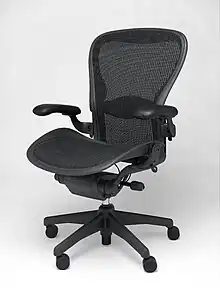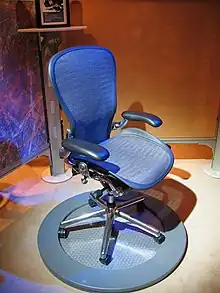Aeron chair
The Aeron chair is an office chair manufactured and sold by American furniture company Herman Miller. Introduced in 1994, it was designed by Don Chadwick and Bill Stumpf and has received numerous accolades for its industrial design. It is featured in the Museum of Modern Art's permanent collection.[1] It has been cited as the best-selling individual office chair in the United States with over 8 million sold.
 The Aeron chair | |
| Designer | Don Chadwick and Bill Stumpf |
|---|---|
| Date | 1994 |
| Sold by | Herman Miller (United States) |
Development
Development of the Aeron chair began in the late 1970s, after Herman Miller hired designers Don Chadwick and Bill Stumpf. They sought to design a chair that improved upon the shortcomings of La-Z-Boy recliners that were often used in residential and medical settings for the elderly, and completed a prototype called the Sarah Chair in 1988. Herman Miller cancelled the Sarah Chair after deeming it unlikely to be commercially viable, and tasked them with designing an office chair.[2]
According to Chadwick, they were tasked by Herman Miller to update the company's previous best-selling office chair, not to design the ideal chair for an eight-hour workday. He said, "We were given a brief and basically told to design the next-generation office chair."[1] They carried over some design concepts from the Sarah Chair, such as a semi-reclining mechanism that simultaneously moved the seat and chairback, to benefit professionals who worked long hours on computers. Early prototypes included foam and upholstery which were abandoned in favor of a fabric mesh called "pellicle" that they found would be more moldable to the user and more breathable, a concept carried over from the Sarah Chair to prevent bedsores. Herman Miller's marketing department was initially apprehensive about selling a chair without upholstery, but the company approved the design.[3] The Aeron chair was introduced in October 1994 and priced at $1,000.[2] It was reportedly named after the Celtic god Aeron, as well as referring to aeration and aeronautics.[4]

The suspended "pellicle" mesh seat and backrest are moulded into glass-fiber reinforced plastic frames.[5] The Aeron chair is made out of recycled materials, and 94 percent of the chair itself is recyclable.[6] It was available in three sizes, A (smallest), B and C (largest), and originally included a height-adjustable lumbar support pad. In 2002, an updated ergonomic support system called PostureFit was introduced to improve lower back support.[7] In 2005, the arms switched from a dial to a lever to loosen for height adjustment.[8] Variants produced include a wheelless version with a flat base named the Aeron Side Chair, and a higher version with a footrest named the Aeron Stool.[9]
In 2016, Herman Miller released a redesigned version of the chair named the Aeron Remastered, later sold and marketed as simply Aeron.[10] Chadwick contributed to the updated design, Stumpf having died in 2006.[11] It includes an updated suspension system, better spine support, a redesigned denser mesh and a re-engineered tilt. Some components that were previously aluminum were switched to plastic.[8] The original version of the chair was given the retronym "Aeron Classic".[12]
Reception

According to Bloomberg, the Aeron chair "made a fetish of lumbar support".[1] Architect Galen Cranz said that while the company is aware that a perching position (facilitated by the chair's rounded front rail) is preferable, it put in the lumbar support to conform to public expectations—"because that's what people think is required for it to be a scientifically 'good' chair."[13] Of the "pellicle" mesh she said, "one of the secrets of the success of that chair was finding that fabric they called ‘pellicle’. That sheer but resistant fabric hit on the right gestalt for where our culture was at."[13]
Sitting expert A. C. Mandal has criticized the Aeron for being "far too low" and not offering enough height adjustment and opportunities for the sitter to move.[1]
The Aeron chair has been credited with revolutionizing the design of office chairs. According to architecture professor Witold Rybczynski, the Aeron was a "rejection of the traditional corporate chair hierarchy," and led to a decline of larger, high-back executive chairs among executives.[14] According to New York, "Aerons were hailed as triumphs of industrial design and were a whole different beast from the overstuffed leather power chairs that dominated the Old Economy."[15] Wired described the Aeron's appearance as "a chair that looked more engineered than designed."[12]
In 1994, before the Aeron chair's general release, Museum of Modern Art curator Paola Antonelli added it to the museum's permanent collection.[16] An Aeron chair is also displayed in the Brooklyn Museum.[17]
Sales and market
The Aeron chair was a success and its sales far exceeded Herman Miller's expectations.[2] Aeron chairs were popular in the offices of Internet startups in the late 1990s, and became associated with the dot-com bubble.[15] Wired noted, "In Silicon Valley, especially, it quickly became a status symbol, visually synonymous with the optimism of the dot-com boom."[12] A 2006 article in New York magazine called the Aeron "the Dot-Com Throne", writing that the chairs "became shorthand for the countless companies that didn't have a clue how to make money on the Internet, but, man, did they have the know-how to set up a cool office". The Aeron was so popular that after the bubble burst, one commenter described the piles of unused chairs as reminiscent of a "corporate graveyard" of office furniture.[18]
In 2010, Bloomberg stated that the Aeron was the best-selling individual office chair in the United States.[1] As of 2023, Herman Miller had sold 8 million chairs, and more than a million chairs are produced every year.[18][19]
See also
References
- "Your Office Chair is Killing You". Bloomberg. 2010-04-29. Retrieved 2016-04-23.
- "The Untold Story Of How The Aeron Chair Was Born". Fast Company. February 5, 2013. Retrieved 28 May 2023.
- Grossman, Anna Jane (2010-12-31). Obsolete: An Encyclopedia of Once-Common Things Passing Us By. ABRAMS. ISBN 978-1-61312-030-9.
'The initial reaction from the marketing people was: You can't sell a chair without upholstery,' says industrial designer Don Chadwick, who codesigned the chair. 'The expectation was always that the big chairs were more comfortable, but we proved that you can have a much more comfortable chair with far less material.'
- "Aeron®: What's in a Name?". SmartFurniture.com. Retrieved 8 September 2014.
- Olivares, Jonathan (2011). A Taxonomy of Office Chairs. London: Phaidon. p. 61. ISBN 978-0-7148-6103-6.
- "Aeron Chair". Herman Miller. Retrieved July 12, 2015.
- "Herman Miller introduces ergonomic innovation to popular Aeron work chair". FMLink. 2002-09-23. Retrieved 2023-06-02.
- Bald, Ryan. "Herman Miller Aeron Classic vs. Remastered (8 Differences)". Retrieved 2023-06-02.
- "Aeron Side Chair By Herman Miller - HML1032". www.madisonseating.com. Retrieved 2023-06-02.
- "Aeron Remastered: Don Chadwick". www.hermanmiller.com. Retrieved 2023-06-02.
- "Herman Miller's Aeron is the only famous office chair for a reason". British GQ. 2021-04-01. Retrieved 2023-05-29.
- Rhodes, Margaret. "Herman Miller Just Redesigned Its Iconic Aeron Chair". Wired. ISSN 1059-1028. Retrieved 2023-05-28.
- Dalton, Melissa (2008). "A Conversation With Galen Cranz" (PDF). Portland Spaces.
- "How well do you know your office chair?". Quartz. 2018-08-10. Retrieved 2023-05-29.
- Kennedy, Brian (2006-09-15). "Remembering the Dot-Com Office Chair -- New York Magazine - Nymag". New York Magazine. Retrieved 2023-05-29.
- "Donald T. Chadwick, William Stumpf. Aeron Office Chair. 1992". Museum of Modern Art. Retrieved 2 October 2015.
- "Brooklyn Museum". www.brooklynmuseum.org. Retrieved 2023-05-29.
- "The Herman Miller Aeron Chair Review - TheCozyOffice.com". TheCozyOffice. 2016-08-25. Retrieved 2017-03-14.
- "Aeron Chair – Herman Miller". store.hermanmiller.com. Retrieved 2023-05-29.